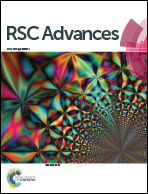In situ synthesis of nanostructured Fe3O4@TiO2 composite grown on activated carbon cloth as a binder-free electrode for high performance supercapacitors†
Abstract
Transition metal oxide (TMO) nanomaterials with regular morphology have received widening research attention as electrode materials due to their improved electrochemical characteristics. In this study we present the successful fabrication of an Fe3O4/TiO2 nanocomposite grown on a carbon cloth (Fe3O4/TiO2@C) used as a high-efficiency electrochemical supercapacitor electrode. Flexible electrodes are directly used for asymmetric supercapacitors without any binder. The increased specific surface area of the TiO2 nanorod arrays provides sufficient adsorption sites for Fe3O4 nanoparticles. An asymmetric supercapacitor composed of Fe3O4/TiO2@C is tested in 1 M Na2SO3 electrolyte, and the synergistic effects of fast reversible Faraday reaction on the Fe3O4/TiO2 surface and the highly conductive network formed by TiO2@C help the electrode to achieve a high areal capacitance of 304.1 mF cm−2 at a current density of 1 mA cm−2 and excellent cycling stability with 90.7% capacitance retention at 5 mA cm−2 after 10 000 cycles. As a result, novel synthesis of a binder-free Fe3O4/TiO2@C electrode provides a feasible approach for developing competitive candidates in supercapacitor applications.



 Please wait while we load your content...
Please wait while we load your content...